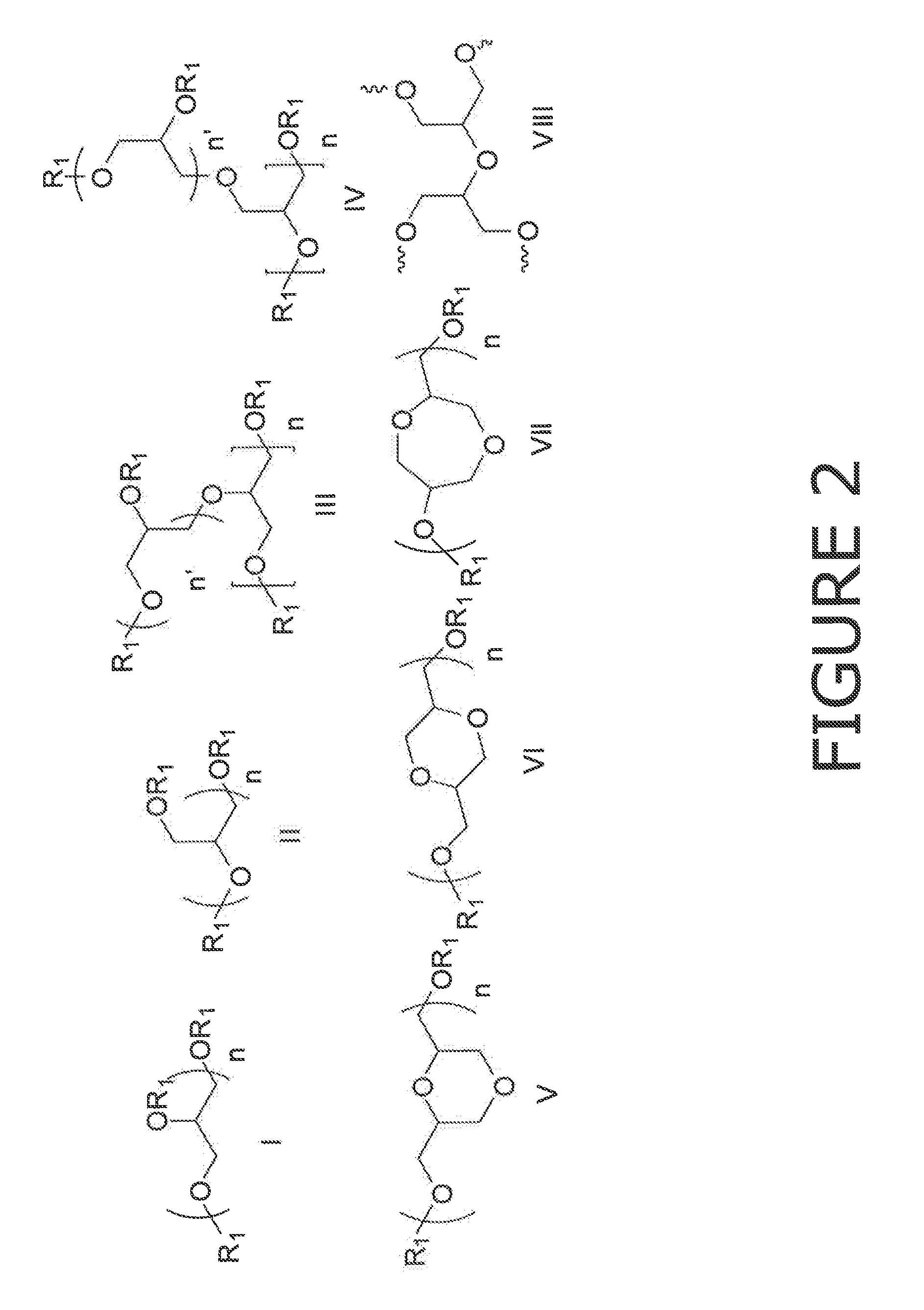Cross-linked glycerol based polymers as digestion aids for improving wood pulping processes
a polymer and cross-linked technology, applied in the field of matter and methods of digesting wood chips, can solve the problems of imposing additional costs and quality control issues, affecting the effectiveness of surfactants, and most surfactants to salt out of solution, so as to increase pulping yield and enhance the penetration of cooking liquor
- Summary
- Abstract
- Description
- Claims
- Application Information
AI Technical Summary
Benefits of technology
Problems solved by technology
Method used
Image
Examples
example 1
Synthesis of a Glycerol-Based Polymer
[0060]100 Units (or using different amounts) of glycerol were added to a reaction vessel followed by 3.0 to 4.0% of active NaOH relative to the reaction mixture. This mixture was agitated and then gradually heated up to 240° C. under a particular low reactivity atmospheric environment of nitrogen flow rate of 0.2 to 4 mol of nitrogen gas per hour per mol of monomer. This temperature was sustained for at least three hours to achieve the desired polyglycerol composition (Table 1), while being agitated under a particular low reactivity atmospheric environment. An in-process polyglycerol sample was drawn before next step for the molecular weight / composition analysis / performance test.
[0061]
TABLE 1Examples of Glycerol-Based PolymersMolecularLactic acidweightweight byDegree ofSample ID(Daltons)*NMR**branching**PGI6,10015%0.32PGII7,80014%0.34Note:*Determined by borate aqueous SEC (size exclusion chromatography) method and calibrated with PEO / PEG standard...
example 2
Synthesis of a Crosslinked Glycerol-Based Polymer
[0062]Polyglycerol from the example 1 (PGI) was dissolved in water as 30-60% solution. To the polyglycerol solution was added 50% NaOH solution (1-15% relative to PGI) at room temperature. After mixing, epichlorohydrin (1-15% relative to PGI) was added, and the resulting reaction mixture was agitated at room temperature for hours until the desired crosslinked glycerol-based polymer formed. The molecular weight of the product was analyzed by SEC (Table 2, CLPG—crosslinked polyglycerol).
[0063]
TABLE 2Examples of Crosslinked Glycerol-Based PolymersPolyglycerolMolecular weightLactic acid weightSample IDused(Daltons)by HPLC***CLPGPGI55,000*NACLHPGPGII 18,000**0.56%Note:*Determined by borate aqueous SEC (size exclusion chromatography) method and calibrated with PEO / PEG standards.**Weight average molecular weight determined by SEC method using PLgel Guard Mixed-D column and DMSO as mobile phase, and calibrated with polysaccharide standards.**...
example 3
Synthesis of a Crosslinked Lipohydrophilic Glycerol-Based Polymer
[0064]To the polyglycerol from the example 1 (PGII) was added H2SO4 (10-22% relative to PGII) at 100-125° C., while agitation under a low reactivity atmospheric environment. The mixture was gradually heated up to 130° C.-150° C. and kept there for at least 30 minutes under a particular low reactivity atmospheric environment, to achieve the desired esterification, C10-C16 alcohols (1-15% relative to PGII) were added. The mixture was heated up to 150° C. and kept there under a particular low reactivity atmospheric environment for at least 30 minutes to achieve the desired alkylation. The resulting reaction mixture was stirred at 150° C. under a particular low reactivity atmospheric environment for at least 30 minutes to achieve the crosslinking to produce the desired end product. The product was dissolved in water (50%) (Table 2, CLHPG—crosslinked lipohydrophilic polyglycerol). During the whole process in-process samples...
PUM
 Login to View More
Login to View More Abstract
Description
Claims
Application Information
 Login to View More
Login to View More - R&D
- Intellectual Property
- Life Sciences
- Materials
- Tech Scout
- Unparalleled Data Quality
- Higher Quality Content
- 60% Fewer Hallucinations
Browse by: Latest US Patents, China's latest patents, Technical Efficacy Thesaurus, Application Domain, Technology Topic, Popular Technical Reports.
© 2025 PatSnap. All rights reserved.Legal|Privacy policy|Modern Slavery Act Transparency Statement|Sitemap|About US| Contact US: help@patsnap.com



